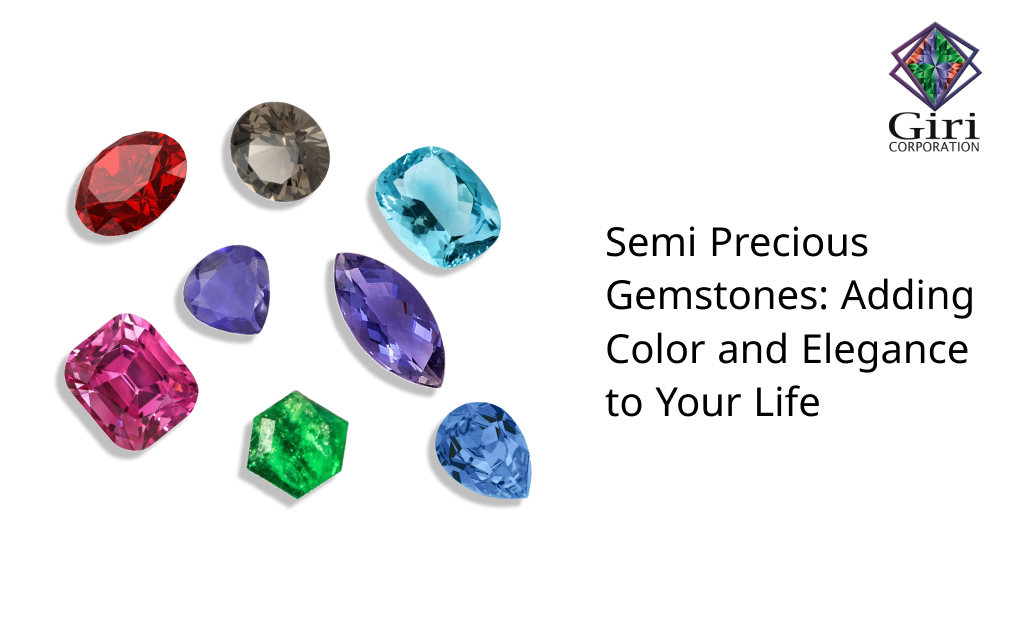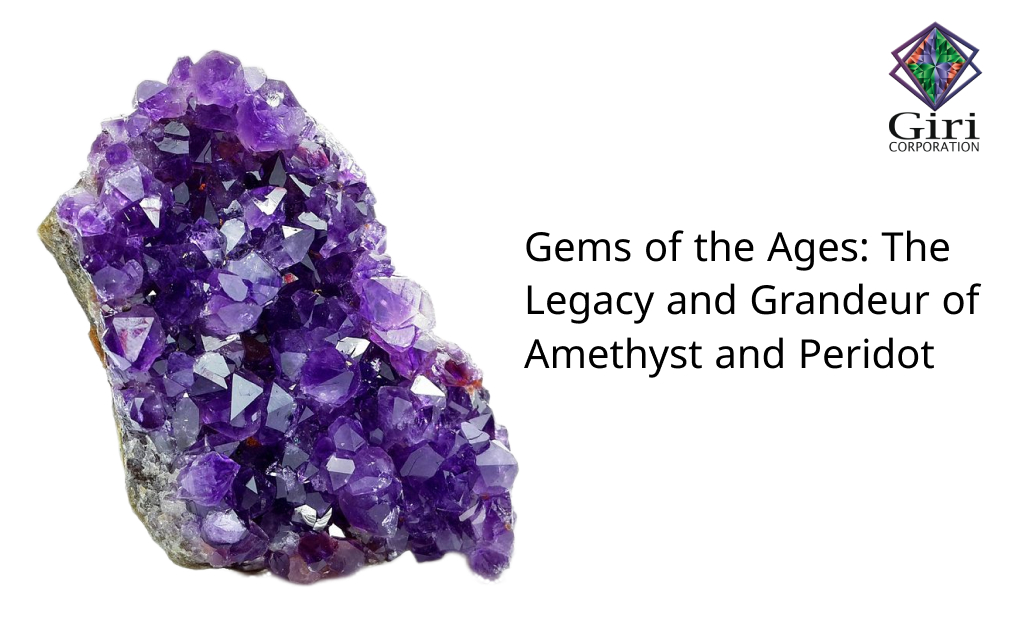Gemstones have long been prized for their radiance and scarcity. For centuries, precious gemstones such as diamonds and rubies have captivated us. However, there is a class of gemstones that is not as well known as their precious counterparts, which are equally beautiful and have deep historical and cultural significance. These are Semi Precious Gemstones.
Each semi-precious gemstone tells its own story with its distinct colors and patterns. From amethyst’s deep purple to peridot’s bright green, these gemstones have been used for thousands of years for their beauty and healing properties. Indeed, some people believe that wearing or carrying semi-precious gemstones can bring good fortune, protect against harm, and even promote physical and emotional well-being.
However, the significance of these semi-precious gemstones extends beyond their beauty and mystical properties. Each stone has a rich history, including tales of ancient civilizations, cultural beliefs, and even wars. So, let us travel through time and investigate the history and significance of some of the most popular semi-precious gemstones.
- Amethyst
Amethyst is a royal gem with healing properties. Its deep purple hues have graced the crowns of kings and queens, and its calming energy has been used for meditation and spiritual practices for centuries.
- History of amethyst
The history of amethyst is as fascinating as its beauty and mystical properties. The ancient Greeks believed that drinking from amethyst-adorned goblets would keep them from becoming drunk. Meanwhile, the Egyptians saw amethyst as a protective stone, carving it into amulets to wear as talismans. During the Middle Ages, amethysts were used to decorate English regalia to represent royalty. Amethyst jewellery has been discovered and dated back to 2000 BC.
- Significance of amethyst
Amethyst is a purple quartz variety that is popular as a gemstone. It has been highly valued throughout history for its beauty, as well as for its symbolic and spiritual meanings. Here are some of the meanings of the amethyst gemstone:
- Spiritual properties: Amethyst is thought to have powerful spiritual properties such as the ability to boost intuition, promote spiritual growth, and deepen meditation practices. It is also said to guard against negative energies and psychic attacks.
- Healing properties: Amethyst is thought to have healing properties that can aid in the treatment of a variety of physical and emotional issues, such as anxiety, stress, insomnia, and addiction. It is also thought to help with detoxification and to strengthen the immune system.
- Symbolism: Amethyst is the February birthstone and is often associated with the zodiac sign Aquarius. It is also the traditional stone for the sixth wedding anniversary. It was used to decorate the crowns and sceptres of kings and queens in ancient times as a symbol of royalty.
- Decorative purposes: Because of its beautiful purple colour, amethyst is widely used in jewellery and other decorative items. It’s also used in sculptures and other forms of art.

Peridot
Peridot is derived from the Arabic word “farida,” which means “gem.” The majority of peridot formed deep within the earth and was brought to the surface by volcanoes; this extraterrestrial peridot is extremely rare and unlikely to be found in a retail jewellery store. Peridot is a stunning gemstone with ethereal beauty. Its vivid green colour is reminiscent of lush forests and vibrant meadows, and its exceptional clarity and transparency make it a favourite among Semi Precious Gemstones collectors.
- History of Peridot
Peridot has been a cherished gemstone for thousands of years. It is a type of olivine, and its green colour is caused by the presence of iron. Peridot’s history is as follows:
- Ancient Egypt: Peridot was mined on the Red Sea volcanic island of Zabargad (now known as St. John’s Island). It was known as “the gem of the sun” by the ancient Egyptians, who believed it protected the wearer from evil spirits. Peridot was also used in jewellery, including King Tutankhamun’s famous burial mask. Some historians believe Cleopatra’s famous emerald collection was made up of peridot. Peridot was frequently confused with emerald in mediaeval times.
- Ancient Rome: Rome regarded peridot as an “evening emerald” because its green colour did not darken at night. Peridot was used in jewellery and was thought to bring wealth and good fortune.
- Middle Ages: Peridot was a popular gemstone, particularly in Europe, during the Middle Ages. It was thought to have healing properties and was used in medicine to treat everything from asthma to liver problems.
- In Hawaiian folklore, peridot is referred to as the “Hawaiian diamond.” Peridot is said to be the tears of the goddess Pele, who is said to live in Hawaii’s volcanoes. The semi precious gemstone is thought to have healing properties and to bring good fortune and protection from evil spirits.
- Peridot was popular again in the nineteenth century, particularly during the Art Nouveau movement. Peridot was used in the designs of jewellers such as René Lalique and Louis Comfort Tiffany and was frequently combined with other gemstones and materials.
- Modern Era: Peridot is still a popular gemstone that is used in a variety of jewellery designs. It is frequently set in yellow gold to accentuate its green colour. Peridot is also used in spiritual and holistic practices, and it is thought to have a calming and revitalising effect on the body and mind.
Peridot has a long history and has been prized for centuries for its beauty, spiritual properties, and healing powers. Peridot is thought to have spiritual and metaphysical properties in addition to its historical and cultural significance. It is said to bring the wearer peace, happiness, and prosperity, as well as protect against negative energy.
Significance of peridot
This semi-precious gemstone has been valued for centuries for its beauty and alleged healing properties. The following are some of the meanings of peridot:
- August birthstone: The birthstone for August is peridot. Those born in this month are said to have good fortune, fortune, and prosperity.
- Protection and healing: Peridot is thought to have protective properties, as well as the ability to ward off evil spirits, negativity, and black magic. It is also thought to have healing properties and to promote overall health, happiness, and well-being.
- Spiritual significance: Peridot was once thought to be a gift from the sun and was revered as a sacred stone. It was believed to bring divine inspiration and enlightenment when used in religious ceremonies.
- Emotional significance: Peridot is said to aid in the release of negative emotions such as anger, jealousy, and resentment, as well as the promotion of feelings of love, forgiveness, and compassion.
Get in Touch, these two Semi Precious Gemstones that are both fascinating and beautiful have captivated people’s imaginations for centuries owing to their unique colours, cultural significance, and alleged healing properties. Amethyst and peridot have a long and varied history, from being used in religious ceremonies and as symbols of love and commitment to promoting emotional balance and spiritual enlightenment. Whether you prefer the regal purple of amethyst or the vibrant green of peridot, these gemstones will add a magical touch to any jewellery collection.

